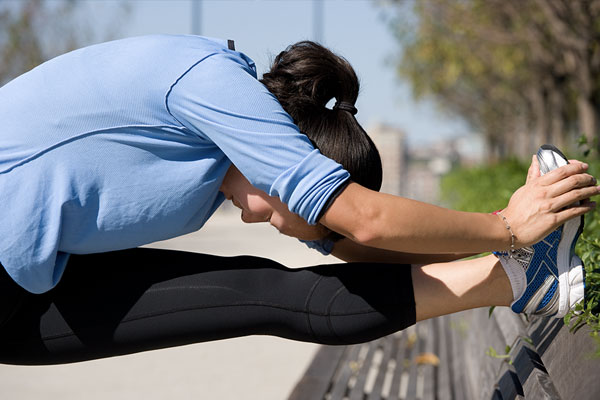A hamstring refers to a solitary ‘string’ comprising three muscles – semitendinosus, semimembranosus, and biceps femoris – situated on the backside of your thighs. An injury or tear of your hamstring resulting from overloading or overstretching could lead to partial or total tearing of the muscles. Hamstring muscle injuries are prevalent in athletes and tend to be quite painful.
Hamstring muscles are essential to movement. They enable you to bend your knees, and together with the quadriceps muscles (at the front of the thigh), they let you extend your knees. These important sets of thigh muscles are used for performing physical activities such as squatting, striding, and walking. Intense athletic activity such as training vigorously for a marathon or a racing competition puts athletes at great risk of suffering a hamstring sprain, strain or injury.
Other possible risk factors for a hamstring tear or sprain include:
- Insufficient warm-up and stretching before workouts
- Muscle weakness due to disproportion or disparity between quadriceps and hamstrings
- Lack of coordination between glutes (muscles in the buttocks) and hamstrings, causing overstraining of the hamstrings
- Ill-fitting or improper footwear
How to Know if You’ve Pulled a Hamstring: Hamstring Injury Symptoms
We thoroughly address how to know if you’ve pulled a hamstring, as well as signs of injury and self assessment techniques in the article “How to Know If You Pulled Your Hamstring”. Symptoms and signs of hamstring injury or sprain are based on the severity or extent of the injury, which can range from mild to severe.
Mild tears cause minimal discomfort. However with a severe tear, you’ll struggle to perform everyday activities like standing, sitting or walking.
A strain or sprain is graded based on the damage suffered by tendon fibers and muscles:
- Tendon fibers that are overstretched but not ripped or torn are considered 1st-grade strains
- Moderate tears of tendon fibers or tears to a section of the muscle are regarded as 2nd-grade strains
- Complete ruptures of the hamstring muscle or the surrounding tendon fibers are classified as a 3rd-grade strains
Pulled Hamstring Treatment and Recovery Time
Mild or minor injuries to the hamstring usually heal fairly quickly. To expedite the healing process, you can adopt the RICE (Rest, Ice, Compression, and Elevation) treatment method. It is the most popular therapeutic method for dealing with hamstring strains and sprains. This time-honored technique of getting plenty of rest, applying ice, using a compression wrap, and elevating your leg are very effective. Sometimes the alternating application of cold and heat help considerably.
Resting
You’ll have to rest your limb as much as possible, which means you’ll need to abstain from exercising or doing laborious work. With a second or 3rd grade hamstring tear, you’ll likely find it difficult to walk, let alone jog or run, as extending or bending will cause the hamstring to stretch or contract, causing extreme pain.
Additionally, you should not put any weight or pressure on the affected leg, and you may have to use crutches for a while to cope with the pain. Your OrthoConnecticut physician will let you know if you’ll need crutches to assist with walking until the pain subsides.
Apply Ice to the Affected Area
Apply ice on the back of your thigh where the hamstring muscle is located to relieve pain and inflammation. Rub the ice repeatedly for 10-15 minutes, every 1-2 hours, for at least a couple of days until you feel the swelling decrease. Use an ice pack, as applying ice directly to the skin can be uncomfortable and could cause frostbite.
Compress the Leg
Your physician will instruct you as to how to maintain compression on the hamstring area. You can use an Ace wrap or elastic bandage for compressing the back of your thigh, which will keep the contusion from enlarging. Wrap one-to-two, 6″ applications from the knee and go up to the thigh, then finish the compression at the hip and groin. Follow your physician’s instructions, and ensure that the compression method is quite firm and taut but not so much to cause pain.
Elevate or Raise Your Leg
Elevating the leg and keeping the limb in a raised position goes a long way in alleviating or reducing tenderness. Leg elevation helps return any fluid build up in the affected area to the torso, which helps reduce soreness or pain in the hamstring muscle. Make sure you rest your leg on a cushion or pillow before you raise the leg.
Medication
Usually, over the counter medications like Advil, Motrin or ibuprofen can help you deal with the pain. However, if you’re taking prescription medicines for another ailment, you must consult your doctor before taking medicines for your hamstring injury. First and 2nd grade sprains or injuries may not require additional therapy, and you should be able to get back to normal activity in 3-4 weeks. Typically, if the symptoms are still present after 3-4 weeks, you’ll need physical therapy. Some atypical more severe 3rd-grade hamstring injuries or strains might necessitate surgery, depending on the number of tendons and muscles that have become damaged.
Pulled Hamstring Recovery Time
The recovery time will be based on the severity of your hamstring injury. Grade one or minor strains should heal in a couple of weeks, while a 3rd-degree tear could take months to heal. Your orthopedic surgeon will help you understand your individual situation and instruct you about how to take the time you need to heal and about resuming activity after your recovery time at home.
Take Away
Hamstring muscle strains and injuries can result from using the muscles excessively or aggressively while doing simple activities like walking or running, or when training intensely for an athletic event. Most often, the sprain or rupture occurs due to an unexpected, abrupt motion. Continuing to perform strenuous workouts or physically demanding activities even after injuring your hamstring, could make the condition worsen.
Hamstring injuries range from mild to severe and require a combination of therapies to heal. Some of the best home remedies include the RICE treatment and wearing a brace, or splint. Physical therapy is often quite helpful once your inflammation has decreased substantially. Your orthopedic surgeon will provide you with a thorough evaluation and treatment protocol to help you recover at home from your hamstring injury and get you back to moving and an active lifestyle.



















